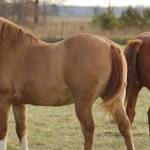How to Approach Weight Loss in Horses

An “obesity epidemic” threatens the world’s horse population, according to some researchers*.
“Studies from all over the world indicate that far too many horses are overweight, putting them at risk for obesity-related health issues such as equine metabolic syndrome and laminitis,” noted Kathleen Crandell, Ph.D., a nutritionist for Kentucky Equine Research.
One study found that 45% of 319 randomly selected horses in Scotland were either “fat” or “very fat,” whereas 54% of 300 American horses were designated “overweight” or “obese.”
What’s the best way to slim your horse’s waistline? Follow these three steps to transform your horse from stout to sleek.
Have a clear start and end point. Objectively assess your horse’s body weight, and then determine what it should weigh. If you are uncertain how to do this, seek the assistance of a Kentucky Equine Research nutrition advisor or your veterinarian. The Henneke nine-point body condition score chart can help you determine how your horse ranks.
“In terms of a body condition score, most horses should fall in the 5-6 range,” Crandell noted. “Some healthy horses might be slightly below this target range, such as a racehorses or peak-level three-day eventers, and an occasional horse might creep higher.” Setting a goal to get your horse into this range and tracking your progress will help stay on target.
Reassess the diet frequently. “Horses generally become overweight due to consumption of excess calories,” explained Crandell adding, “Because obesity is actually viewed by many as a welfare issue, owners need to critically assess what their horse really needs in terms of calories.”
If fed hay-based diets, most horses maintain appropriate body condition when given 1.5-2% of their body weight in hay. If horses have access to pasture, the amount of hay required drastically decreases. In fact, some horses, especially those that are prone to metabolic disorders, should be turned out in drylots or fitted with grazing muzzles to minimize intake of unnecessary calories.
“In addition, spring pastures tend to be loaded with fructans and nonstructural carbohydrates that can induce laminitis in at-risk horses and ponies. This includes any equine that is overweight or already diagnosed with equine metabolic syndrome,” Crandell stated.
Stick to your horse’s diet and avoid diet drift and reinstituting ill-advised dietary habits, such as offering unnecessary supplements, concentrates, and treats.
Don’t forget exercise. Studies show that dietary restriction alone may not be the best approach to weight loss. Instead, incorporate routine exercise into a horse’s daily life. The chosen exercise should respect a horse’s level of fitness, athleticism, and soundness.
“It’s always a good idea to have your horse examined by a veterinarian prior to implementing dietary changes or an exercise program,” Crandell recommended.
*Elzinga, S., S. Reedy, V.D. Barker, et al. 2018. Humoral and cell-mediated immune responses to influenza vaccination in equine metabolic syndrome (EMS) horses. Veterinary Immunology and Immunopathology 199:32-38.








